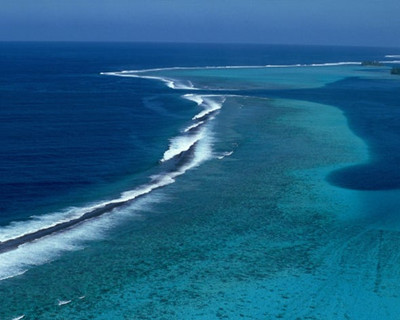(单词翻译:单击)
听力文本
This is Scientific American's 60-second Science, I'm Christopher Intagliata.
A physics lesson may be the last thing on your mind as you relax at the ocean, however:
"If you're sitting on a lovely Hawaiian beach with your Mai Tai and you're looking offshore and you see 20-foot waves and people surfing on them, and you notice that it's only lapping up on the shoreline here with teeny little waves, that's the reef working to dissipate that energy."
Mike Beck studies the intersection of engineering, ecology, economics and finance at UC Santa Cruz. He says reefs act a whole lot like our human-built coastal infrastructure to tame the energy of incoming waves.
"Coral reefs act just like a low crested submerged breakwater. That's an engineering term. But it means there are really good engineering models for describing the benefits of reefs."

And those models are the key behind a new report from the U.S. Geological Survey, with Beck as one of its authors. The researchers modeled hypothetical storms hitting coastlines in areas with offshore reefs, like Florida, Hawaii and Puerto Rico. They studied how reefs of various heights would dampen waves and hold back flooding, and they found that every year the country's reefs save the U.S. an estimated $1.8 billion dollars in direct flooding damages and other economic losses.
That dollar number is important because it allows reef rebuilding projects—like gluing little healthy coral nubbins on damaged reefs—to tap into billions of dollars of federal money set aside for hurricane and disaster resilience.
"If you can rigorously value the benefits of any of these habitats, you can unlock any of the funding mechanisms that would have typically been applied to developing a seawall or a breakwater."
That's a win-win—for life below the water and for those of us who live on land as well.
Thanks for listening for Scientific American — 60-Second Science. I'm Christopher Intagliata.
参考译文
这里是科学美国人——60秒科学系列,我是克里斯托弗·因塔格里塔。
当你在海边放松时,物理课可能是你最不会想起的事,但是:
“如果你拿着迈泰鸡尾酒坐在美丽的夏威夷海滩,向海面望去,你会看到20英尺高的海浪以及在上面冲浪的人们,你还会注意到极小的海浪拍打着海岸线,而这是珊瑚礁正在消耗能量。”
迈克·贝克在加州大学圣克鲁兹分校研究工程学、生态学、经济学和金融学交叉学科。他表示,珊瑚礁很像我们人类建造的沿海基础设施,可以抑制涌向岸边的海浪的能量。
“珊瑚礁的作用就像低顶水下防波堤。这是工程学术语。这意味着我们有相当好的工程模型来描述珊瑚礁的益处。”
这些模型是美国地质调查局一份新报告的关键,贝克是该报告的作者之一。研究人员模拟了风暴袭击海岸有近海珊瑚礁区的场景,比如佛罗里达、夏威夷和波多黎各的海岸。他们研究了不同高度的珊瑚礁如何抑制海浪和洪水,他们发现,美国的珊瑚礁每年为美国减少了约18亿美元的直接洪水损失和其它经济损失。
这些美元数额非常重要,因为它使珊瑚礁重建项目——比如在受损的珊瑚礁上粘上健康的珊瑚礁小块——可以动用联邦政府为飓风和灾后恢复划拨的数十亿美元资金。
“如果你能严格评估这些栖息地的益处,你就能启动任何通常用于建造海堤或防波堤的筹资机制。”
这是种双赢局面——对生活在水下的生命还有对生活在陆地上的我们来说,都是如此。
谢谢大家收听科学美国人——60秒科学。我是克里斯托弗·因塔利亚塔。
译文为可可英语翻译,未经授权请勿转载!
重点讲解
重点讲解:
1. lap up 拍打;舔食;
Rice shoots in the terraced fields were greedily lapping up the dew.
梯田里的秧苗贪婪地吮吸露水。
2. hold back 阻挡;阻止;
It is always futile to try to hold back the progress of history.
要想阻止历史潮流是徒劳的。
3. set aside 留作…之用;留出…用于;
130 million pounds would be set aside for repairs to schools.
将划拨1.3亿英镑用于学校的修缮。
4. apply to 应用;运用;
The new technology was applied to farming.
这项新技术已应用于农业。


